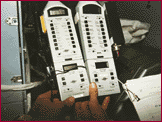


Objectives
The Mir Audible Noise Measurement investigation was designed to determine where acoustic mitigation may be required to ensure crew protection if Russian hardware exceeded noise level limits.
Shuttle-Mir Missions Approach Results
The NC 50 curve was exceeded at all measurement locations except in the Kvant-2 airlock compartment. Mir science and exercise activities during the docked period of STS-74 were low; transfer operations predominated during this period. Sound level meter data, dosimeter measurements, and questionnaire responses are understandably different due to the varying lengths and places of noise exposure.
Overall, the crew's subjective impressions of the Mir acoustic environment was favorable. However, the limited time of exposure and lack of science and exercise activities during the docked period may have skewed the responses. While the NC 50 curve is exceeded, the sound pressure levels at all locations were lower than anticipated based on past data documentation.
Earth Benefits Publications
Bieirie J. Mir Acoustic Environment. 26Th International Conference on Environmental Systems; 1996 Jul 8-11; Monterey, California; Society of Automotive Engineers.
Principal Investigators![]()
STS-74
The MANM hardware (sound level meter, one-third-octave filter, microphone, acoustic dosimeter, audio recorder, and headphones) was taken to the Mir and positioned in 10 locations within the designated modules. Sound levels were measured in the core module (3 locations), Kvant-2 (3 locations), Kvant (1 location), Spektr (2 locations), and the docking module (1 location). Crewmembers noted the location using the audio recorder and took sound level measurements. Sound level measurements were taken about the center frequencies of 63, 125, 250, 500, 1000, 2000, 4000, and 8000 Hz. Questionnaires were also completed during flight to document the crewmembers' subjective acceptability of the measured noise levels.
All ten planned locations were measured, and all desired sound level meter data were captured with the exception of the higher frequency spectral data for the Kvant-2 airlock. The lowest sound pressure levels in Mir existed at this location and dropped below the sound level meter range chosen.
High noise levels have long been known to be detrimental to hearing. By monitoring noise levels, mission planners can anticipate the types and levels of protection the astronauts will need when entering noisy work areas. These precautions are a regular part of operations a power plants and car manufacturing companies around the country.
Lofton R, Conley C. International Space Station Phase 1 Risk Mitigation and Technology Demonstration Experiments. 48Th International Astronautical Congress; 1997 Oct 6-10; Turin, Italy; International Astronautical Federation.
C. Parsons
NASA/Johnson Space Center
![]()
|
|
Curator:
Julie Oliveaux
Responsible NASA Official: John Uri |
Page last updated: 07/16/1999
.gif)